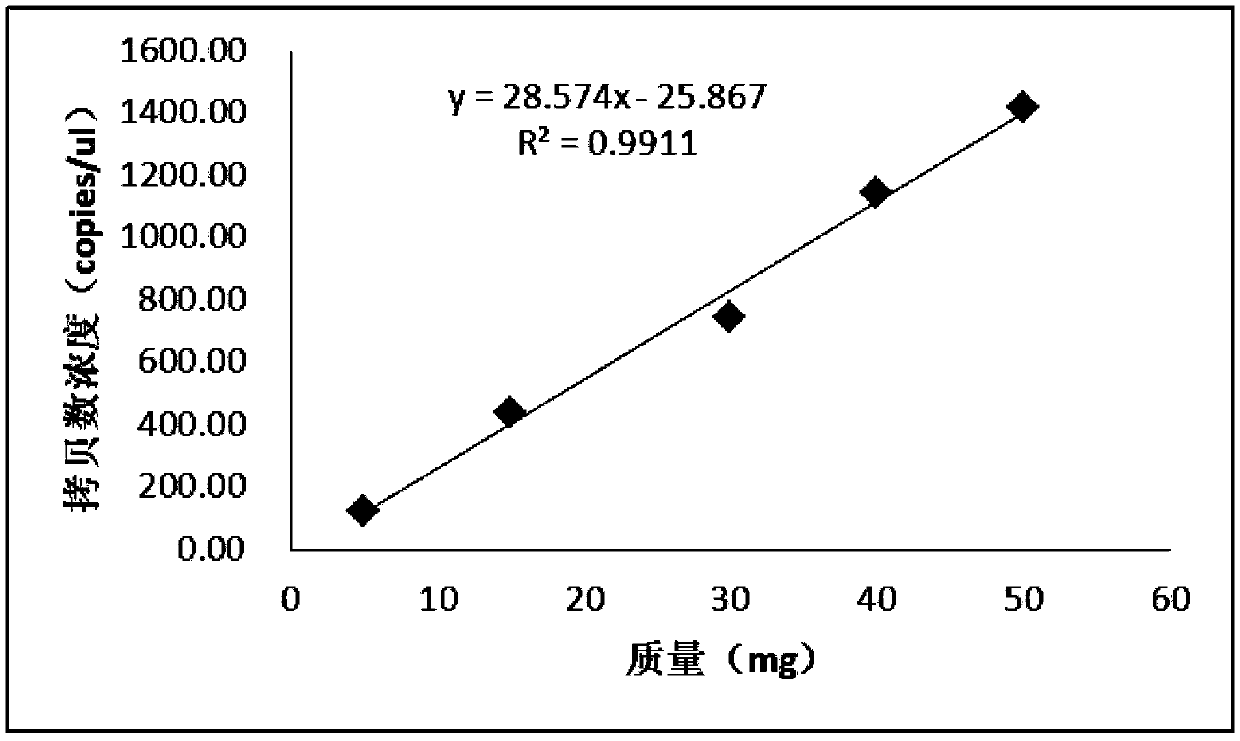Kit for quantitatively detecting solanum tuberosum component based on microdroplet digital PCR (Polymerase Chain Reaction) and application of kit
A quantitative detection and micro-droplet digital technology, applied in the field of molecular biology detection, can solve the problems of inability to obtain accurate quantitative measurement results, fail to meet the needs of the industry, and cumbersome operation steps, and achieve wide application range, good specificity, and easy operation steps. easy effect
- Summary
- Abstract
- Description
- Claims
- Application Information
AI Technical Summary
Problems solved by technology
Method used
Image
Examples
Embodiment 1
[0054] specificity test
[0055] Genomic DNA was extracted from potato, sweet potato, cassava, yam, taro, eggplant, carrot, tomato, celery, rice, soybean and barley crops, using the upstream primer of the ST-LS1 gene (tgctctttctatatgatctcggataatt, SEQID No.1), ST The downstream primer of LS1 gene (aggacaaaaagaaaaaactgattggt, SEQ ID No.2) and the probe of ST-LS1 gene (aactggtctccaacaggcaacaaccca, SEQ ID No.3) were amplified by fluorescent quantitative PCR. The reaction program of the fluorescent quantitative PCR is as follows: 95°C, 5min, 1°C / s; 94°C, 15s, 1°C / s, 60°C, 1min, 1°C / s, a total of 40 cycles; 98°C, 10min, 1°C / s.
[0056] Among the above 12 crops, only potato samples were specifically detected (potatoes with specific S-shaped amplification curves), and no other crops were detected (see figure 1 ). This shows that the primer probe designed in the present invention is specific to the detection of potato and has good specificity.
Embodiment 2
[0058] Linear relationship between potato mass (mg) and copy number concentration (copies / μL)
[0059] Weigh 5mg, 15mg, 30mg, 40mg, 50mg of gradient quality potato flour samples, use Wizard GenomicDNApurification kit (Promega, A1120) to extract genomic DNA, use 20μL digital PCR reaction system (2×ddPCR TM 10 μL of master mix; 0.5 μL of upstream primers with a concentration of 10 μmol / μL, 0.5 μL of downstream primers with a concentration of 10 μmol / μL, 0.4 μL of probes with a concentration of 10 μmol / μL, 2 μL of DNA templates, and water up to 20 μL. ddPCR reaction conditions are: 95°C, 5min (1°C / s); 94°C, 15s (1°C / s), 60°C, 1min (1°C / s), a total of 40 cycles; 98°C, 10min (1°C / s), and store the reaction product at 12°C. After the amplification, the 96-well plate was placed in a droplet analyzer to read the fluorescence signal, and the experimental data was analyzed with QuantaSoftV1.3.2 software.
[0060] The obtained data are shown in Table 1, and the linear relationship dat...
Embodiment 3
[0064] Determination of the Limit of Detection (LOD) and Limit of Quantification (LOQ) of Potato DNA Concentration
[0065] Using DNA concentration gradients of 21ng / μL, 4.2ng / μL, 0.84ng / μL, 0.17ng / μL and 0.06ng / μL, each gradient has three parallels, and the potato DNA concentration copy number test results are shown in Table 2. The heat map of the test results of potato DNA concentration and copy number is shown in image 3 . Judgment conditions are: LOQ is based on the detected copy number concentration at which the RSD of the test result is less than 25%, and LOD is based on the copy number concentration that can be detected in no less than 9 out of 10 parallels.
[0066] Table 2 Potato DNA concentration copy number test results
[0067]
[0068] Table 3 shows the LOD and LOQ test results of 10 parallel groups when the DNA concentration is 0.17 and 0.06 ng / μL respectively. Figure 4 is the heat map of the potato DNA concentration gradient LOD and LOQ test.
[0069] Tab...
PUM
 Login to View More
Login to View More Abstract
Description
Claims
Application Information
 Login to View More
Login to View More - R&D
- Intellectual Property
- Life Sciences
- Materials
- Tech Scout
- Unparalleled Data Quality
- Higher Quality Content
- 60% Fewer Hallucinations
Browse by: Latest US Patents, China's latest patents, Technical Efficacy Thesaurus, Application Domain, Technology Topic, Popular Technical Reports.
© 2025 PatSnap. All rights reserved.Legal|Privacy policy|Modern Slavery Act Transparency Statement|Sitemap|About US| Contact US: help@patsnap.com



